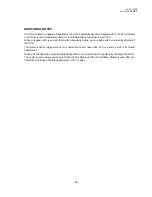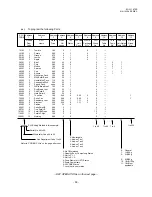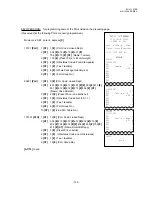
- 85 -
EO3-11070
MA-1650-4 SERIES
Address No.
Description of Programming Contents
-- Continued --
9
Sub-link Department Code
•
This entry is useful when the department item entry should always be
followed by another department’s item sale. If the department is not applied
to this case, skip this address entry. Refer to the following examples of
applications.
HEAD-LINK DEPT.
SUB-LINK DEPT.
Example 1)
Dept. 1 (for Bottle
Dept. 2 (for Bottle
Drink Net Content
Deposit entries)
Sales entries)
Example 2)
Dept. 14 (Battery-
Dept. 27 (Batteries)
drive Clocks)
As shown in the examples, this feature prevents the cashier from forgetting to
enter the Sub-link Dept. item attached to the Head-link Dept. item. And at the
same time, in reports, two Department Totals are separately read.
•
In setting, enter the Sub-link Department Code (1 to 99). (The Main-link
Dept. is the dept now being programmed.)
[#]
1 to 99 (Sub-link Department Code)
•
To cancel the sub-linking, enter 0 instead of the Sub-link Dept. Code before
[#].
•
REMARKS:
1)
When the Head-link Dept. item is entered in a sale, an entry through
the Sub-link Dept. will be required. No other operations will be
accepted until the Sub-link Dept. is operated.
2)
The HEAD-to-SUB linkage is effective for only one step. If the Sub-
link Dept. is further set with another Sub-link Dept., the first HEAD
item will only require its own Sub-link Dept. entry.
3)
It is possible to set multiple departments as Head-link to one Sub-link
Department. (For example, multiple departments are assigned for
bottled drink entries but only one department is assigned for bottlle-
deposit entries.)
4)
The Sub-link Dept. alone may be operated for sale entries, skipping
the Head-link Dept., without affecting the Head-link Dept. sales
memory.
5)
Various declaration keys, multiplications, etc. may be operated on
each of the Head-link and Sub-link depts., independently from the
other.
-- Continued on next page --
















































